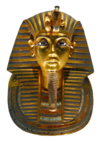Portal:Ägyptologie
Diskussion
Ägyptologie
Nützliches
Artikel
Artikeländerungen
Ur- und Frühgeschichte · Alter Orient · Altertum · Ägyptologie · Griechische Antike · Römisches Reich · Byzanz · Mittelalter · Heiliges Römisches Reich · Frühe Neuzeit · Britisches Weltreich · Preussen · Österreich-Ungarn · Deutsches Kaiserreich · 19. Jahrhundert · Sezessionskrieg · Wilder Westen · 20. Jahrhundert · Imperialismus und Weltkriege · Sowjetunion · Nationalsozialismus · DDR
Qualitätsprädikat:
Auf dieser Seite verwendete Medien
Autor/Urheber: Ricardo Liberato, Lizenz: CC BY-SA 2.0
All Gizah Pyramids in one shot.
Autor/Urheber: Jeff Dahl, Lizenz: CC BY-SA 4.0
Anubis, the jackal headed god of ancient Egypt. Anubis is also depicted in full jackal form perched atop a tomb, guarding it.[1] Based on New Kingdom tomb paintings.
Autor/Urheber: Einsamer Schütze, Lizenz: CC BY-SA 3.0
Kopf einer Statue des Königs Chephren
Autor/Urheber:
- Crystal_Clear_app_kedit.svg: w:User:Tkgd, Everaldo Coelho and YellowIcon
- derivative work: Andreas P. (talk)
An recreation of an icon from icon theme Crystal Clear.
Autor/Urheber: Vyacheslav Stepanyuchenko from Rostov-on-Don, Russian Federation, Lizenz: CC BY 2.0
The Theban Necropolis is located on the west bank of the Nile, opposite Luxor, in Egypt. As well as the more famous royal tombs located in the Valley of the Kings and Queens, there are numerous other tombs, more commonly referred to as Tombs of the Nobles, the burial places of some of the powerful courtiers and persons of the ancient city.
Autor/Urheber: NebMaatRa, Lizenz: GPL
Diagonalsternuhr in Särgen des Mittleren Reiches im Alten Ägypten.
- Sarg des Nacht, wohl aus Assiut, 11./12. Dynastie.
Autor/Urheber:
- Tutanchamun_Maske.jpg: en:User:MykReeve
- derivative work: GDK (talk)
Goldene Totenmaske des Tutanchamun im Ägyptischen Museum Kairo.
Autor/Urheber: Guillaume Blanchard, Lizenz: CC BY-SA 3.0
List of some hieroglyphs:
(3-lines-(read into faces)(line 1-(right)-starts)) :#–3-strokes (plural); two-varieties, examples, lines 1 and 3 :#–Hotep, (plus a "p", and a "t" complements)(often found with the hotep hieroglyph)
Autor/Urheber:
- Nofretete.jpg: Nina Aldin Thune
- derivative work: GDK (talk)
Nefertiti Bust - Berlin
Cartouche that contains the hieroglyphic signs that render Tutankhamun's personal name with his usual epithet, "Tutankhamun, ruler of On of Upper Egypt [a name for Thebes]," and his throne name, "Nebkheperura".
This image was copied from wikipedia:en. The original description was: This image is extracted from Infofocalpoint.com, an article called, "Howard Carter, and other archeologists who discovered King Tut, are blamed for much of the damage to his bodily remains," and is a direct transcription of ancient heiroglyphics.[1]Autor/Urheber: Der ursprünglich hochladende Benutzer war Ulrich.fuchs in der Wikipedia auf Deutsch, Wikipedia Logo: Wikimedia Foundation, Lizenz: CC BY-SA 3.0
Banner Qualitätsoffensive






















